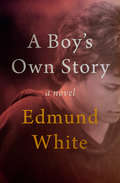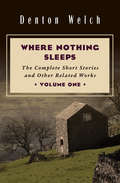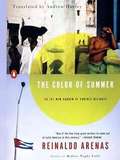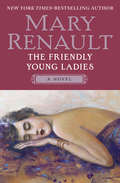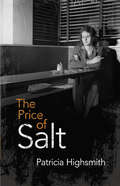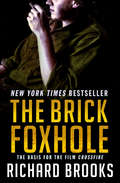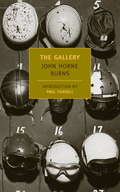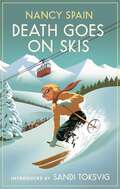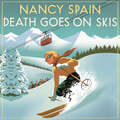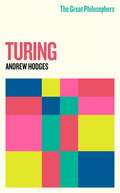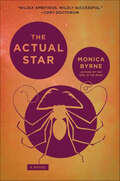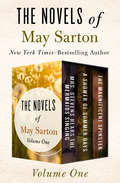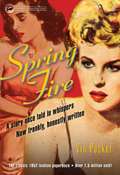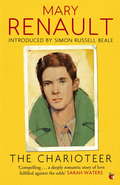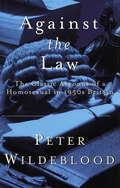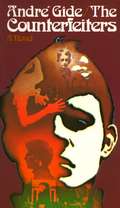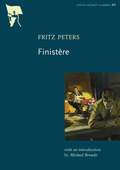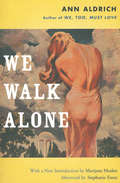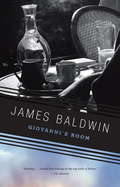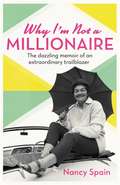- Table View
- List View
A Boy's Own Story: A Novel (Modern Library #47)
by Edmund White&“An extraordinary novel&” about growing up gay in the 1950s American Midwest (The New York Times Book Review). Critically lauded upon its initial publication in 1982 for its pioneering depiction of homosexuality, A Boy&’s Own Story is a moving tale about coming-of-age in midcentury America. With searing clarity and unabashed wit, Edmund White&’s unnamed protagonist yearns for what he knows to be shameful. He navigates an uneasy relationship with his father, confounds first loves, and faces disdain from his peers at school. In the embrace of another, he discovers the sincere and clumsy pleasures of adolescent sexuality. But for boys in the 1950s, these desires were unthinkable. Looking back on his experiences, the narrator notes, &“I see now that what I wanted was to be loved by men and to love them back but not to be a homosexual.&” From a winner of the PEN/Saul Bellow Award for Lifetime Achievement in Literature, this trailblazing autobiographical story of one boy&’s youth is a moving, tender, and heartbreaking portrait of what it means to grow up.
Where Nothing Sleeps: The Complete Short Stories and Other Related Works (Where Nothing Sleeps #1)
by Denton WelchThe first volume of Denton Welch's complete collected short works English novelist Denton Welch originally trained as a visual artist, and a painterly perspicacity and talent for human observation are evident in his writing. His close attention to detail renders even the most seemingly mundane trivialities memorable and important. Though he died at the young age of thirty-three, Welch was quite prolific, doing most of his writing while bedridden after a bicycling accident that left him seriously injured. He produced three novels, over seventy-five short stories, and a journal that ran over two hundred fifty thousand words long. Included in this volume are autobiographical works inspired by Welch's youth in China, such as "I Can Remember" and "The Coffin on the Hill." "I First Began to Write" is a brief vignette detailing Welch's early efforts as an author. These stories, fragments, and poems reveal a writer gifted with superb powers of description.
The Little Less
by Angela Du MaurierThis is a novel about a lesbian relationship. The author is the sister of Daphne Du Maurier.
The Color of Summer: or The New Garden of Earthly Delights (Pentagonia)
by Thomas Colchie Andrew Hurley Reinaldo ArenasCritics worldwide have praised Reinaldo Arenas's writing. His extraordinary memoir, Before Night Falls, was named one of the fourteen "Best Books of 1993" by the editors of The New York Times Book Review and has now been made into a major motion picture.The Color of Summer, Arenas's finest comic achievement, is also the fulfillment of his life's work, the Pentagonía, a five-volume cycle of novels he began writing in his early twenties. Although it is the penultimate installment in his "secret history of Cuba," it was, in fact, the last book Arenas wrote before his death in 1990. A Rabelaisian tale of survival by wits and wit, The Color of Summer is ultimately a powerful and passionate story about the triumph of the human spirit over the forces of political and sexual repression.
The Friendly Young Ladies: A Novel (Virago Modern Classics Ser. #72)
by Mary RenaultA wry romp through 1930s mores, social and sexualProgressive for its time as well as ours, The Friendly Young Ladies is a deftly witty comedy set in England between the wars. At eighteen, Elsie has had enough of life at her bickering parents&’ Cornwall home. She decides to join up with her bohemian older sister, Leo, in the city. Leo&’s life is full of surprises—not least her significant other, Helen, a beautiful nurse. As Elsie gets acquainted with Leo&’s world, new characters—including a novelist and a doctor deluded enough to chase all three women at once—come into play. With acid humor and a supremely light touch, The Friendly Young Ladies colors in an unseen dimension of the 1930s.
The Price of Salt: OR Carol
by Patricia HighsmithA chance encounter between two lonely women leads to a passionate romance in this lesbian cult classic. Therese, a struggling young sales clerk, and Carol, a homemaker in the midst of a bitter divorce, abandon their oppressive daily routines for the freedom of the open road, where their love can blossom. But their newly discovered bliss is shattered when Carol is forced to choose between her child and her lover.Author Patricia Highsmith is best known for her psychological thrillers Strangers on a Train and The Talented Mr. Ripley. Originally published in 1952 under a pseudonym, The Price of Salt was heralded as "the novel of a love society forbids." Highsmith's sensitive treatment of fully realized characters who defy stereotypes about homosexuality marks a departure from previous lesbian pulp fiction. Erotic, eloquent, and suspenseful, this story offers an honest look at the necessity of being true to one's nature. The book is also the basis of the acclaimed 2015 film Carol, starring Cate Blanchett and Rooney Mara.
The Brick Foxhole
by Richard BrooksNew York Times Bestseller: This “shocking” murder mystery addresses homophobia in the military during World War II (Richard Wright, author of Native Son). The men in the barracks, wrenched from the normal pursuits of life, are being molded into warriors in a battle against the “others.” Isolated and fearful, they sometimes relieve their frustrations on the most disenfranchised civilians, namely homosexuals. But one weekend, one of them loses control and commits murder. This tale of suspense is also a story ahead of its time, written by a young marine stationed at Quantico who would go on to become an Academy Award–winning director of such films as Elmer Gantry and The Blackboard Jungle. Sinclair Lewis, writing in Esquire, called Richard Brooks “a really important new writer” and The Brick Foxhole was acclaimed in the Saturday Reviewof Literature as “angry, rapid, stream-lined, and beautifully written . . . the best of the new stuff coming out of this war”—though the US Marines threatened the author with court-martial. Eventually, the story was made into the movie Crossfire (with the hate crime in question changed to an act of anti-Semitic rather than antigay violence), which earned Brooks an Edgar Award for Best Motion Picture. Today, The Brick Foxhole remains both a twisting thriller and an early landmark of gay-themed fiction.
The Gallery
by David Margolick John Horne Burns Paul Fussell"The first book of real magnitude to come out of the last war." --John Dos Passos John Horne Burns brought The Gallery back from World War II, and on publication in 1947 it became a critically-acclaimed bestseller. However, Burns's early death at the age of 36 led to the subsequent neglect of this searching book, which captures the shock the war dealt to the preconceptions and ideals of the victorious Americans. Set in occupied Naples in 1944, The Gallery takes its name from the Galleria Umberto, a bombed-out arcade where everybody in town comes together in pursuit of food, drink, sex, money, and oblivion. A daring and enduring novel--one of the first to look directly at gay life in the military--The Gallery poignantly conveys the mixed feelings of the men and women who fought the war that made America a superpower.
Death Goes on Skis: Introduced by Sandi Toksvig - 'Her detective novels are hilarious' (Virago Modern Classics #800)
by Nancy Spain'Her detective novels are hilarious - less about detecting than delighting, with absurd farce and a wonderful turn of phrase . . . Nancy Spain was bold, she was brave, she was funny, she was feisty. I owe her a great deal' Sandi ToksvigMiriam Birdseye is daring, brilliant - and a long way from The Ivy. Our dashing heroine, a famous revue artist, takes to the slopes with her coterie of admirers. Champagne flows and wherever Miriam goes she leaves a trail of gossip in her wake.Fellow ski-resort guests include the celebrated Russian ex-ballerina, Natasha Nevkorina, whose beauty is matched only by her languor, Natasha's burly husband, nightclub owner Johnny DuVivien, and the wealthy Flahertés, a family who have made their money importing scents: handsome playboy Barney, his wife Regan, their two obnoxious children and the governess, Rosalie. Unbeknownst to Regan, Barney's mistress, a film star, is also there with her husband.When secrets start to unravel, tensions rise, and soon amateur sleuths Miriam and Natasha have not one but two murders to solve. In the hands of Nancy Spain, for whom farce and humour are a lot more fun than a conventional detective novel, the result is a deliciously wild ride.'An either intense or sombre approach to crime is to Miss Spain foreign: in her world an inspired craziness rules . . . Her wit, her zest, her outrageousness, and the colloquial stylishness of her writing are quite her own' Elizabeth Bowen
Death Goes on Skis: Introduced by Sandi Toksvig - 'Her detective novels are hilarious'
by Nancy Spain'Her detective novels are hilarious - less about detecting than delighting, with absurd farce and a wonderful turn of phrase . . . Nancy Spain was bold, she was brave, she was funny, she was feisty. I owe her a great deal' Sandi ToksvigMiriam Birdseye is daring, brilliant - and a long way from The Ivy. Our dashing heroine, a famous revue artist, takes to the slopes with her coterie of admirers. Champagne flows and wherever Miriam goes she leaves a trail of gossip in her wake.Fellow ski-resort guests include the celebrated Russian ex-ballerina, Natasha Nevkorina, whose beauty is matched only by her languor, Natasha's burly husband, nightclub owner Johnny DuVivien, and the wealthy Flahertés, a family who have made their money importing scents: handsome playboy Barney, his wife Regan, their two obnoxious children and the governess, Rosalie. Unbeknownst to Regan, Barney's mistress, a film star, is also there with her husband.When secrets start to unravel, tensions rise, and soon amateur sleuths Miriam and Natasha have not one but two murders to solve. In the hands of Nancy Spain, for whom farce and humour are a lot more fun than a conventional detective novel, the result is a deliciously wild ride.'An either intense or sombre approach to crime is to Miss Spain foreign: in her world an inspired craziness rules . . . Her wit, her zest, her outrageousness, and the colloquial stylishness of her writing are quite her own' Elizabeth Bowen
Death Goes on Skis: Introduced by Sandi Toksvig - 'Her detective novels are hilarious' (Virago Modern Classics #800)
by Nancy Spain'Her detective novels are hilarious - less about detecting than delighting, with absurd farce and a wonderful turn of phrase . . . Nancy Spain was bold, she was brave, she was funny, she was feisty. I owe her a great deal' Sandi ToksvigMiriam Birdseye is daring, brilliant - and a long way from The Ivy. Our dashing heroine, a famous revue artist, takes to the slopes with her coterie of admirers. Champagne flows and wherever Miriam goes she leaves a trail of gossip in her wake.Fellow ski-resort guests include the celebrated Russian ex-ballerina, Natasha Nevkorina, whose beauty is matched only by her languor, Natasha's burly husband, nightclub owner Johnny DuVivien, and the wealthy Flahertés, a family who have made their money importing scents: handsome playboy Barney, his wife Regan, their two obnoxious children and the governess, Rosalie. Unbeknownst to Regan, Barney's mistress, a film star, is also there with her husband.When secrets start to unravel, tensions rise, and soon amateur sleuths Miriam and Natasha have not one but two murders to solve. In the hands of Nancy Spain, for whom farce and humour are a lot more fun than a conventional detective novel, the result is a deliciously wild ride.'An either intense or sombre approach to crime is to Miss Spain foreign: in her world an inspired craziness rules . . . Her wit, her zest, her outrageousness, and the colloquial stylishness of her writing are quite her own' Elizabeth Bowen
The Great Philosophers: Turing (GREAT PHILOSOPHERS)
by Andrew HodgesAlan Turing's 1936 paper On Computable Numbers, introducing the Turing machine, was a landmark of twentieth-century thought. It settled a deep problem in the foundations of mathematics, and provided the principle of the post-war electronic computer. It also supplied a new approach to the philosophy of the mind.Influenced by his crucial codebreaking work in the Second World War, and by practical pioneering of the first electronic computers, Turing argued that all the operations of the mind could be performed by computers. His thesis, made famous by the wit and drama of the Turing Test, is the cornerstone of modern Artificial Intelligence.Here Andrew Hodges gives a fresh and critical analysis of Turing's developing thought, relating it to his extraordinary life, and also to the more recent ideas of Roger Penrose.
The Fox
by D. H. LawrenceLawrence's brilliant story of two women and the intruder who threatens their love.
The Actual Star: A Novel
by Monica ByrneDavid Mitchell’s Cloud Atlas meets Octavia Butler’s Earthseed series, as acclaimed author Monica Byrne (The Girl in the Road) crafts an unforgettable piece of speculative fiction about where humanity came from, where we are now, and where we’re going—and how, in every age, the same forces that drive us apart also bind us together."A stone-cold masterpiece."—New ScientistThe Actual Star takes readers on a journey over two millennia and six continents—telling three powerful tales a thousand years apart, all of them converging in the same cave in the Belizean jungle.Braided together are the stories of a pair of teenage twins who ascend the throne of a Maya kingdom; a young American woman on a trip of self-discovery in Belize; and two dangerous charismatics vying for the leadership of a new religion, racing toward a confrontation that will determine the fate of the few humans left on Earth after massive climate change.In each era, a reincarnated trinity of souls navigates the entanglements of tradition and progress, sister and stranger, and love and hate—until all of their age-old questions about the nature of existence converge deep underground, where only in complete darkness can they truly see.
The Novels of May Sarton Volume One: Mrs. Stevens Hears the Mermaids Singing, A Shower of Summer Days, and The Magnificent Spinster
by May SartonThree luminous novels from a New York Times–bestselling author and National Book Award finalist whose “prose leaves compelling echoes in one’s mind” (The New York Times Book Review). Throughout her long and acclaimed career, May Sarton refused to be categorized. As a memoirist, poet, and novelist, she broke new ground by openly exploring homosexuality, gender inequality, and other once taboo social issues. Gathered here in one volume are three of her most memorable and moving works of fiction. Mrs. Stevens Hears the Mermaids Singing: Widely regarded as her most important work, Sarton’s 1965 semiautobiographical novel centers upon Hillary Stevens, an author now in her twilight years. As she prepares to publish anew, Stevens sits down to discuss her life, the arc of her creative journey, and her love affairs—with both men and women. “The plot of this short novel is deceptively simple, the mood subtle, the feeling intense” (The New York Times Book Review). A Shower of Summer Days: The Irish estate home Dene Court has been shuttered for years—but this summer Violet Dene Gordon and her husband Charles return from British Burma, electrifying life in the sleepy village that adjoins Violet’s childhood home. As an added complication, Violet’s American niece is being sent to Ireland to separate her from an unsuitable romantic attachment. A National Book Award finalist, “A Shower of Summer Days establishes once and for all [Sarton’s] unmistakable authority” (The New York Times Book Review). The Magnificent Spinster: This “absolutely compelling . . . monument to love . . . [and] friendship” is actually the story of two women: Cam, the novel’s narrator, and the recently deceased Jane Reid. Unmarried and childless, Jane left no family to remember her, so Cam sets out to immortalize the life of her quietly remarkable friend and teacher in fiction (The Cleveland Plain Dealer).
Spring Fire
by Vin PackerHer silky black hair. Her low-cut gown. Her sparkling sorority pin. It's autumn rush in the Tri Epsilon house, and the new pledge, Susan Mitchell-"Mitch" to her friends-trembles as the fastest girl on campus, the lovely Leda Taylor, crosses the room toward her for a dance. Will Leda corrupt Mitch? Or will the strong and silent Mitch draw the queen of Tri Ep into the forbidden world of Lesbian Love?Spring Fire was the first lesbian paperback novel and sold an amazing 1.5 million copies when it first appeared in 1952. It launched an entire genre of lesbian novels, as well as the writing career of Vin Packer, one of the pseudonyms of prolific author Marijane Meaker, whose acclaimed memoir, Highsmith: A Romance of the 1950s, told the story of her own forbidden love. Now available after forty years out of print, Spring Fire is both a vital part of lesbian history and a steamy page-turner.
The Charioteer: A Virago Modern Classic (Virago Modern Classics #323)
by Mary Renault'The Charioteer remains compelling both as a snapshot of a particular - and particularly fascinating - cultural moment, and as a deeply romantic story of love fulfilled against the odds. It has all those qualities that make Mary Renault so memorable as a novelist: craft, subtlety, intelligence, and a terrific natural sympathy with the intricacies of honour and desire' SARAH WATERS'An explosive and courageous book' SIMON RUSSELL BEALEFirst published in 1953, The Charioteer is a tender, intelligent coming-of-age novel and a bold, unapologetic portrayal of homosexuality that stands with Gore Vidal's The City and the Pillar and James Baldwin's Giovanni's Room as a landmark work in gay literature.Injured at Dunkirk, Laurie Odell, a young corporal, is recovering at a rural veterans' hospital. There he meets Andrew, a conscientious objector serving as an orderly, and the men find solace in their covert friendship. Then Ralph Lanyon appears, a mentor from Laurie's schooldays. Through him, Laurie is drawn into a tight-knit circle of gay men for whom liaisons are fleeting and he is forced to choose between the ideals of a perfect friendship and the pleasures of experience.'Emotionally intelligent, beautifully written and deeply moving, it transcends categorisations' Telegraph
Against The Law
by Peter Wildeblood'This right which I claim for myself and for all those like me is the right to choose the person whom I love' Peter WildebloodIn March 1954 Peter Wildeblood, a London journalist, was one of five men charged with homosexual acts in the notorious Montagu case. Wildeblood was sentenced to eighteen months in prison, along with Lord Montagu and Major Michael Pitt-Rivers. The other two men were set free after turning Queen's Evidence.Against the Law tells the story of Wildeblood's childhood and schooldays, his war service, his career as a journalist, his arrest, trial and imprisonment, and finally his return to freedom. In its honesty and restraint it is eloquent testimony to the inhumanity of the treatment of gay men in Britain within living memory.
Against The Law
by Peter Wildeblood'This right which I claim for myself and for all those like me is the right to choose the person whom I love' Peter WildebloodIn March 1954 Peter Wildeblood, a London journalist, was one of five men charged with homosexual acts in the notorious Montagu case. Wildeblood was sentenced to eighteen months in prison, along with Lord Montagu and Major Michael Pitt-Rivers. The other two men were set free after turning Queen's Evidence.Against the Law tells the story of Wildeblood's childhood and schooldays, his war service, his career as a journalist, his arrest, trial and imprisonment, and finally his return to freedom. In its honesty and restraint it is eloquent testimony to the inhumanity of the treatment of gay men in Britain within living memory.
The Counterfeiters: A Novel (Vintage International)
by Andre GideA young artist pursues a search for knowledge through the treatment of homosexuality and the collapse of morality in middle class France.
Finistère
by Fritz Peters Michael BronskiA lyrical gay coming-of-age story first published in 1951, acclaimed by Gore Vidal and The New York Times, about Matthew, a young American who moves to France with his mother following his parents' divorce. As Matthew navigates his budding sexuality and complicated new relationships, he is forced to confront finistère--land's end--where the brutal truths of the world can be found. Includes an appendix of materials about the book and author, as well as an introduction by acclaimed author Michael Bronski. Part of the Little Sister's Classics series, which resurrects out-of-print gay and lesbian books from the past.
We Walk Alone
by Ann AldrichThe 1950s queer-life groundbreaker by &“a literary pioneer . . . [who] forever changed perceptions of same-sex love and desire&” (Advocate.com). Ann Aldrich flung a provocative assertion at her readers in 1955 when she opened her landmark account of lesbian life in New York City by saying this book was the &“result of fifteen years of participation in society as a female homosexual.&” After the release of We Walk Alone, Aldrich became both a heroine and a scapegoat in some of the period&’s most contentious public debates over what exactly &“lesbian culture&” was. Her non-fiction pulp literally transformed the landscape overnight, and &“the effect on women was electric. From every corner of creation, they wrote wrenching letters of relief and gratitude&” (Ann Bannon, author of The Beebo Brinker Chronicles). Part Kinsey-esque portraits of real people, part you-are-there reports on the scene in bars and offices and at clubs and house parties, We Walk Alone is revealing and compelling composite of an alienated yet amazingly self-aware community—one that Aldrich would revisit three years later in We, Too, Must Love. Today, &“these essential cultural artifacts&” (UTNE Magazine), as Stephanie Foote explains in her afterword, are &“as rich and conflicted a look at the formation of lesbian urban culture as that of any contemporary queer historian.&”
Giovanni's Room: Go Tell It On The Mountain / Giovanni's Room / Another Country / Going To Meet The Man (Vintage International #2)
by James BaldwinSet in the 1950s Paris of American expatriates, liaisons, and violence, a young man finds himself caught between desire and conventional morality. With a sharp, probing imagination, James Baldwin's now-classic narrative delves into the mystery of loving and creates a moving, highly controversial story of death and passion that reveals the unspoken complexities of the human heart.
The Well Of Loneliness
by Radclyffe HallOriginally published in 1928, Radclyffe Hall's The Well of Loneliness is the timeless story of a lesbian couple's struggle to be accepted by "polite" society. When an unconventional woman named Stephen Gordon falls in love with an ingenue named Mary, their love affair gives Stephen her first taste of happiness. However, the pleasure the lovers find in each other is quickly tarnished by the disapproval of friends and family who refuse to welcome the "scandalous" couple in their homes. But the most difficult test of the women's love for each other comes when a young man offers to give Mary the "respect-ability" that Stephen can not. The Well of Loneliness is the thinly disguised story of Radclyffe Hall's own life. Shockingly candid for its time, this novel was the very first to condemn homophobic society for its unfair treatment of gays and lesbians. Banned outright in 1928, its publication marked an act of great courage which almost ruined Hall's literary career. Although half a century has passed since its initial publication, the issues of prejudice and persecution that Radclyffe Hall addresses remain sadly relevant today
Why I'm Not A Millionaire: The dazzling memoir of an extraordinary trailblazer
by Nancy SpainThe superb classic memoir from a dazzlingly eccentric and endlessly fascinating author - a woman very much ahead of her time.'She was bold, she was brave, she was funny, she was feisty. I owe her a great deal in leading the way' Sandi ToksvigNancy Spain was one of the most celebrated - and notorious - writers and broadcasters of the 40s, 50s and 60s. Hilarious, controversial and brilliant, she lived openly as a lesbian (sharing a household with her two lovers and their various children) and was frequently litigated against for her newspaper columns - Evelyn Waugh successfully sued her for libel... twice. She was also a fantastic crime novelist (and according to the Guardian, one of the 50 best female crime thriller writers of all time) writing with a unique style that marries the acid wit of Dorothy Parker with the intricacy of plotting worthy of Agatha Christie. WHY I AM NOT A MILLIONAIRE, has the same wit, style and fascinating detail - first published in 1956, with an introductory note from Noel Coward. After her death in a plane crash in 1964, Noel Coward commented: 'It is cruel that all that gaiety, intelligence and vitality should be snuffed out, when so many bores and horrors are left living.'
